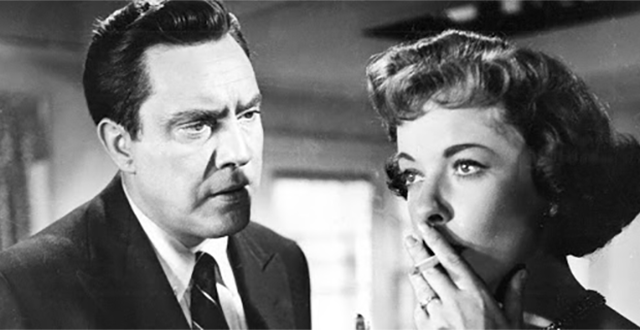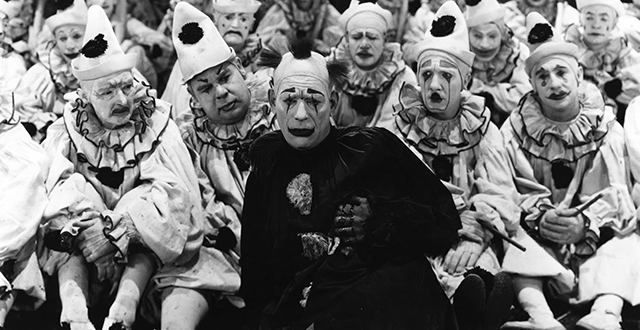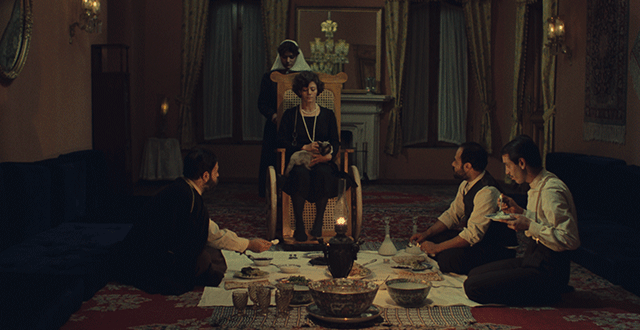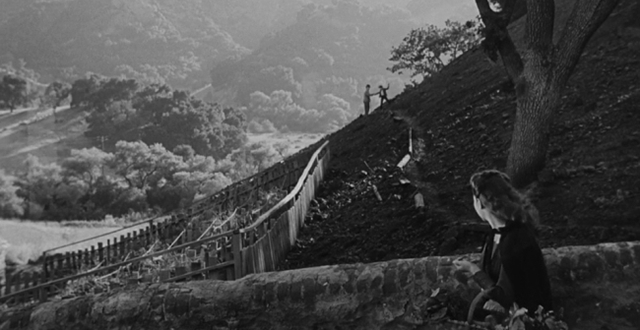News
Out of the Vaults: “The Bigamist”, 1953
Meher Tatna
In an op-ed in the New York Times upon her death in 1955, Martin Scorsese wrote this about Ida Lupino: “I never met Ida Lupino, but I always wanted to. Her tough, emotional acting is well remembered, but her considerable accomplishments as a filmmaker are largely forgotten. She was a true pioneer; the six films she directed between 1949 and 1953 are remarkable chamber pieces that deal with challenging subjects in a clear, almost documentary fashion, and are a singular achievement in American cinema.”
Star of 60 films and director of eight, Ida Lupino was a trailblazer in the studio era, writing and directing movies made by her own independent production company, The Filmakers (sic), which she set up with her second husband, Collier Young.
The Bigamist is her best-known work, a film noir movie – a genre of black and white dramas with an antihero protagonist, fast dialogue, and tawdry storylines. It starred Joan Fontaine, Lupino herself, Edmund Gwenn, and Edmond O’Brien. In a matter of art reflecting life, the screenwriter/producer was the aforementioned Collier who was now married to Fontaine after divorcing Lupino. It was the only film in which she directed herself. And possibly the only instance of a woman directing her ex-husband’s current wife. Another echo of her own life: she was pregnant with third husband Howard Duff’s child at the time of her divorce with Young, a storyline of The Bigamist.
Fontaine and O’Brien play a couple in San Francisco who want to adopt a child. He is a salesman for the company they run together and is forever on the road; she buries herself in work to forget her childlessness. During an investigation of their backgrounds, their adoption agent, played by Gwenn, finds out that O’Brien has been living a double life with a wife (Lupino) and child in Los Angeles. The storyline is simple. There are no subplots, no extraneous characters, no nudging the audience’s feelings in a particular direction with a crashing score underlining bad behavior from a villain. The sensitive portrayal of a betrayer and lawbreaker by O’Brien engages the audience’s sympathies in a way they don’t see coming. From the start of the film to its ambiguous finish, it is a perceptively directed film dealing with an inflammatory subject that would have been handled very differently with a male director at that time. Even the poster falls short of the breathless headlines of film noir, stating simply: “Wanted by Two Women” above the credits.
A couple of interesting bits of trivia: in the story, O’Brien’s character meets Lupino’s on a bus tour of the stars’ homes in Beverly Hills – Jack Benny’s and Jimmy Stewart’s homes on Roxbury Drive are pointed out by the bus driver, along with Edmund Gwenn’s as the star of Miracle on 34th Street. And Lupino’s landlady is played by Fontaine’s mother, Lillian Fontaine.
In the press book of one of her earlier films, The Hitch-Hiker, Lupino said this of her work in a male-dominated world:
“I retain every feminine trait. Men prefer it that way. They’re more co-operative if they see that fundamentally you are of the weaker sex even though you are in a position to give orders, which normally is the male prerogative, or so he likes to think, anyway. While I’ve encountered no resentment from the male of the species for intruding into their world, I give them no opportunity to think I’ve strayed where I don’t belong. I assume no masculine characteristics, which can often be a fault of career women rubbing shoulders with their male counterparts, who become merely arrogant or authoritative.”
The title of the article from which this quote is taken was “Ida Lupino Retains Her Femininity as Director.” It’s easy to see why she didn’t want to threaten male directors with her ambition in an era where sexism was rampant in Hollywood and where it still exists, to an extent, to this day.
She wrote the following in an article in the DGA’s magazine Action in 1967 entitled “Me, Mother Directress” in which she explained why she turned to directing:
“For about eighteen months back in the mid-Forties I could not get a job in pictures as an actress ... I was on suspension ... when you turned down something you were suspended ... I had to do something to fill up my time.”
She was referring to her fight with Warner Bros. who tried to force her into films she didn’t want to make, particularly with Humphrey Bogart who she couldn’t stand after working with him in High Sierra.
Because of Scorsese’s admiration for Lupino, The Bigamist was selected by him as one on a long list of must-restore movies. While it is now in the public domain, the restoration process was done by the UCLA Film & Television Archive in cooperation with Republic Pictures, with funding provided by The Film Foundation and the Hollywood Foreign Press Association. It was preserved in cooperation with Republic Pictures from the original 35mm acetate picture and soundtrack negatives.
The Bigamist was distributed by The Filmakers after RKO (owned by Howard Hughes), did not renew their distribution deal. The production company folded two years later as Lupino and Young couldn’t afford to distribute their own films, lacking the financial wherewithal of the studios. The movie is included in the book “1001 Movies You Must See Before You Die” edited by Steven Schneider.
This would be the last film Lupino directed for more than 12 years. She made a career as a television director in her later years.
COMMEMORATING 30 YEARS OF TFF
Back in the 90s, there was a stunning series of MGM silents programmed by Bruce Goldstein at Film Forum here in New York—one remarkable film after another, from Stroheim’s Merry Widow to Rex Ingram’s Mare Nostrum and The Four Horsemen of the Apocalypse to what was for me the great revelation of that series, He Who Gets Slapped, later restored by the George Eastman Museum with the help of The Film Foundation. This was the very first MGM film to go into production (but not the first release) and the first title to feature the MGM lion in its logo, the first film under Irving Thalberg’s supervision, and most importantly of all the American debut of the great Swedish director Victor Sjöström. I vividly remember the powerful gravitational sway of He Who Gets Slapped, based on a play by Leonid Andreyev (known for a time in this country as “the Russian Edgar Allen Poe”). It’s an unusually potent melodrama of male humiliation and degradation, one of many in the early 20th century, and it has a dramatic starkness and a visual purity that are hair-raising. What did Sjöström and his great star Lon Chaney, brought to MGM from Universal by Thalberg, find together? How did they harmonize to the point where they seemed creatively conjoined? Such a thing can’t really be explained, just seen, absorbed, marveled at. Sjöström found the same kind of relationship with Lillian Gish in the two great films they made together, The Scarlet Letter and The Wind, and three decades later Ingmar Bergman found it with Sjöström as an actor in Wild Strawberries.
It is possible to see He Who Gets Slapped. There’s a Warner Archive DVD and you can find it on a few streaming platforms. But to discover it on the big screen is far less likely than it was in the 90s. Repertory cinema has been in a fragile state for a long time, but right now it’s more vulnerable than ever—Film Forum, which I mentioned before, has been closed since March and is still awaiting guidance on reopening. 35mm prints are now as rare as Grecian urns. A majority of titles are now “owned” by corporate entities for which the very question of cultural patrimony seems either irrelevant, inadmissible or unheard of—hard to say which. We’ve never been able to take the ongoing availability of cinema for granted. Now, on about six different fronts, we all have to fight for it as if our lives depended on it.
- Kent Jones
Follow us on Facebook, Instagram, and Twitter!
HE WHO GETS SLAPPED (1924, d. Victor Sjostrom)
Preserved by the George Eastman Museum with funding provided by The Film Foundation.
Revivals Lineup Announced for the 58th New York Film Festival

Film at Lincoln Center announces Revivals for the 58th New York Film Festival (September 17 – October 11).
“We are thrilled with our selections for Revivals, a section reshaped for the 2020 edition of NYFF to showcase the relevance, the vitality, and the beauty of yesterday’s cinema,” said Florence Almozini, FLC Senior Programmer at Large. “The program covers the ’70s to the ’90s, from Europe to Asia to the U.S., and features seminal works by Wong Kar Wai, Joyce Chopra, Hou Hsiao-hsien, Marie-Claude Treilhou, William Klein, Jia Zhangke and more, in outstanding restorations. Together, these films reveal an enduring influence on our collective sense of cinema, culturally and politically, for filmmakers as well as audience members.”
The Revivals section connects cinema’s rich past to its dynamic present through an eclectic assortment of new restorations, titles selected by the festival’s filmmakers, rarities, and more. Highlights include a major rediscovery of Iranian cinema, Mohammad Reza Aslani’s The Chess Game of the Wind, and another NYFF58 appearance by Main Slate filmmaker Jia Zhangke, with his rarely screened Xiao Wu—both made possible by the dedicated work of The Film Foundation, celebrating its 30th anniversary this year; the sumptuous visual pleasures of Hou Hsiao-hsien’s Flowers of Shanghai and Wong Kar Wai’s In the Mood for Love, featuring two of Tony Leung’s most memorable roles; portraits of iconic American figures that resonate today in William Klein’s Muhammad Ali, the Greatest and Terence Dixon’s Meeting the Man: James Baldwin in Paris, shot by Jack Hazan; Joyce Chopra’s 1986 Sundance Grand Jury Prize winner, Smooth Talk, which boasts a breakout performance by a young Laura Dern; and Marie-Claude Treilhou’s Simone Barbes or Virtue, a stylish curio long overdue for reappraisal. Rounding out the program are Béla Tarr’s black-and-white noir, Damnation; Wojciech Has’s hallucinatory masterpiece, The Hourglass Sanatorium; and Jean Vigo’s Zero for Conduct, a celebration of the anarchy of youth selected by Opening Night director Steve McQueen as an influence on his Small Axe films.
Revivals will be presented in a combination of virtual and drive-in screenings; the full festival schedule will be announced in the coming weeks. Limited rentals of Meeting the Man: James Baldwin in Paris and Zero for Conduct will be available free for NYFF audiences.
The Revivals section is programmed by Florence Almozini and Dan Sullivan with program advising by Gina Telaroli.
Since 1963, the New York Film Festival has been a centerpiece of New York’s arts scene: an annual bellwether of the state of cinema that has shaped film culture in the city and beyond. Festival organizers will keep this tradition alive while adapting as necessary to the current health crisis. The safety of audiences and staff is the first priority. The 58th edition of NYFF will focus on outdoor and virtual screenings, as directed by state and health officials.
In May, organizers unveiled a reimagined festival structure under the leadership of new NYFF Director Eugene Hernandez and NYFF Director of Programming Dennis Lim. The festival’s offerings have been streamlined into five sections, including the previously announced Main Slate. Currents, Spotlight, and Talks will be announced in the coming weeks.
Presented by Film at Lincoln Center, the New York Film Festival highlights the best in world cinema. The festival continues a long-standing tradition of introducing audiences to bold and remarkable works from celebrated filmmakers as well as fresh new talent. Press and industry accreditation for the 58th New York Film Festival is now open through September 2. Tickets will go on sale to the general public on September 11, with early access opportunities for FLC members prior to this date. See details about ticket prices and passes here. Support of the New York Film Festival benefits Film at Lincoln Center in its nonprofit mission to support the art and craft of cinema.
FILMS & DESCRIPTIONS
The Chess Game of the Wind
Mohammad Reza Aslani, 1976, Iran, 93m
Farsi with English subtitles
An unheralded landmark of Iranian cinema, Mohammad Reza Aslani’s debut feature is set during the rule of the Qajar dynasty and chronicles the fallout when a noble family’s matriarch passes away, kindling tensions new and old among her heirs. Screened publicly just once and long thought lost after the 1979 Revolution, The Chess Game of the Wind evokes the work of Luchino Visconti in its sumptuous, refined, and poetic rendering of aristocratic decadence, the passage of time, the ties that bind, and the desires that set us against one another. Featuring a remarkable score by the trailblazing female film composer Sheyda Gharachedaghi and masterfully lensed by Houshang Baharlou with a candle-lit grandeur reminiscent of Kubrick’s Barry Lyndon, The Chess Game of the Wind ranks among the great recent (re)discoveries of world cinema. Restored by Cineteca di Bologna at L’Immagine Ritrovata and The Film Foundation’s World Cinema Project. Funding provided by the Hobson/Lucas Family Foundation.

 Chess of the Wind. Courtesy of The Film Foundation.
Chess of the Wind. Courtesy of The Film Foundation.
Damnation
Béla Tarr, 1986, Hungary, 116m
Hungarian with English subtitles
A key turning point in Béla Tarr’s career, the first of the director’s six collaborations with novelist László Krasznahorkai signaled a visible shift away from the verité realism of his early features and toward the highly stylized, black-and-white otherworldliness that would become his signature. The story is a kind of desiccated film noir, focusing on the efforts of a dour loner, Karrer (Miklós Székely B.), to steal back his estranged lover—a lounge singer (Vali Kerekes) in a funereal bar named Titanik—from her debt-addled husband. Karrer lures the husband into a smuggling scheme that will force him to leave town, but these well-laid plans soon go awry, and the characters play out their doomed destiny through enveloping layers of rain, shadow, and despair. An Arbelos Films release. New 4K restoration by the Hungarian National Film Institute – Film Archive.
Flowers of Shanghai
Hou Hsiao-hsien, 1998, Taiwan, 113m
Cantonese & Shanghainese with English subtitles
An NYFF regular from relatively early in his career, Hou Hsiao-hsien made his seventh festival appearance with this ravishingly beautiful chamber drama that follows the intertwined fortunes and intrigues of four “flower girls” serving in the opulent brothels of fin-de-siècle 19th-century Shanghai. The great Tony Leung stars as the melancholy Master Wang, torn between his affections for the jealous, demanding Crimson (Michiko Hada) and the more eager-to-please Jasmin (Vicky Wei), and gradually realizing that he is looking for love in all the wrong places. Hou’s first film set outside his native Taiwan, Flowers of Shanghai is a transfixing masterwork and an achingly, intoxicatingly sensuous landmark of ’90s world cinema. A Janus Films release. Restored in 4K in 2019 from the 35mm original negative by Shochiku in collaboration with the Shanghai International Film Festival at the L’Immagine Ritrovata laboratory. With funding provided by Jaeger-LeCoultre.

 Flowers of Shanghai. Courtesy of Janus Films.
Flowers of Shanghai. Courtesy of Janus Films.
The Hourglass Sanatorium
Wojciech Has, 1973, Poland, 124m
Polish with English subtitles
The collective trauma of the Holocaust looms over this adaptation of Jewish author Bruno Schulz’s visionary and poetic reflection on the nature of time and death, which won the Jury Award at Cannes. Józef (Jan Nowicki) finds himself aboard a train en route to visit his father in the hospital; he arrives to find the hospital in a state that’s a bit less than… orderly. From there, past and present, reality and fantasy, collapse into each other, unleashing a surreal phantasmagoria that is by turns psychedelic, paranoiac, elegiac, funny, and everywhere haunted by the specter of death: both Józef’s prophesied death and the death of a Europe that existed before the rise of Hitler, the horrors of the Holocaust, and the carnage of World War II. New 4K restoration from the original camera negative, produced by Fixafilm (Łukasz Cerenka, Andrzej Łucjanek), supervised by Łukasz Ceranka, and curated by Daniel Bird.

 Hourglass Sanatorium. Courtesy of Fixafilm.
Hourglass Sanatorium. Courtesy of Fixafilm.
In the Mood for Love
Wong Kar Wai, 2000, Hong Kong, 98m
Cantonese and Shanghainese with English subtitles
Wong Kar Wai’s swoon-inducing instant classic made Maggie Cheung and Tony Leung the star-crossed dream team of the early 2000s art house. They play next-door neighbors who, upon discovering that their spouses are carrying on an affair, start a platonic romance of their own amid the alleyways and noodle shops of 1960s Hong Kong. The breathless, will-they-won’t-they tension is pushed to intoxicating heights by the luscious mise en scène: Christopher Doyle’s caressing cinematography; the sensuous use of slo-mo; the red- and green-saturated and patterned print-galore period art direction (that wallpaper!); and the haunting, endlessly repeating strains of Nat King Cole. “Quizás, quizás, quizás…” A Janus Films release. This 4K digital restoration was undertaken from the 35mm original camera negative by the Criterion Collection, in collaboration with Jet Tone Films, L’Immagine Ritrovata, One Cool, and Robert Mackenzie Sound. Supervised and approved by Wong Kar Wai.
Meeting the Man: James Baldwin in Paris
Terence Dixon, 1971, UK/France, 27m
This rare film document of one of the towering figures of 20th-century American literature—photographed by Jack Hazan (Rude Boy, A Bigger Splash)—captures the iconic writer in several symbolic locations, including the Place de la Bastille. As Hazan recounts: “Things don’t go to plan for him and the film crew when a couple of young Black Vietnam draft dodgers impose themselves on the American. Baldwin wrestles with being a role model to the Black youths, denouncing Western colonialism and crimes against African Americans while at the same time demonstrating his mastery and understanding of the culture he supposedly despises.” Restored from a 2K scan of the 16mm original color negative A&B rolls and the 16mm optical negative. Scanning services by UPP, Prague. Picture and audio restoration, grading, and mastering by Mark Rance, Watchmaker Films, London. The film is presented in 1.37:1.

 Meeting the Man: James Baldwin in Paris. Courtesy of Buzzy Enterprises Ltd.
Meeting the Man: James Baldwin in Paris. Courtesy of Buzzy Enterprises Ltd.
Muhammad Ali, the Greatest
William Klein, 1974, France, 123m
English and French with English subtitles
A masterful study of one of the greatest boxers of all time and a key cultural and political figure of his era, Klein’s portrait of Muhammad Ali ranks among the most enjoyable, provocative, and candid sports documentaries. Focusing on the lead-ups to and aftermaths of three of Ali’s defining bouts—the two fights with Sonny Liston in 1964 and ’65, and the “Rumble in the Jungle” with George Foreman in ’74—Klein vividly captures Ali in his element as well as the sociopolitical climate surrounding the champ. Featuring some of the most enthralling footage of Ali boasting ever committed to celluloid, Muhammad Ali, the Greatest is an astonishing work that renders its beyond-charismatic subject in all his prowess (verbal and physical), complexity, and majesty. Presented by Films Paris New York and ARTE. First digital 2K restoration from the original 16mm negative scanned in 4K with the support of the CNC. Image works by ECLAIR Classics and sound by L.E.DIAPASON.
Simone Barbes or Virtue / Simone Barbès ou la vertu
Marie-Claude Treilhou, 1980, France, 77m
French with English subtitles
A criminally overlooked work from the post-post-New Wave era of French cinema, Marie-Claude Treilhou’s feature debut assumes the form of a triptych, following leather-clad porno theater usher Simone (Ingrid Bourgoin) as she banters with her coworker (Martine Simonet) while watching the eccentric strangers puttering in and out of the cinema’s lobby; then clocks out and heads off to meet her girlfriend, a waitress at a lesbian club; and later, has an encounter with a lonely man on the prowl (Cahiers du cinéma critic Michel Delahaye). But the minimalist plot of Simone Barbes almost seems besides the point: Treilhou’s film is saturated with style and atmosphere, the chargedness of each throwaway gesture, idle remark, or seemingly empty moment yielding a character study unlike any other. 4K scan and restoration by Cosmodigital for La Traverse with the support of the CNC.
Smooth Talk
Joyce Chopra, 1985, USA, 92m
In her first lead role, 18-year-old Laura Dern gave one of her most stirring, layered performances in an adaptation of Joyce Carol Oates’s 1966 short story “Where Are You Going, Where Have You Been?” She stars as Connie Wyatt, a teenager who spends her summer days moping around the house and exploring her sexuality in the Northern California suburbs. But the thrills and innocence of youth are forever shaded by the predatory behavior of an older man named Arnold Friend (Treat Williams) whom she encounters at a drive-in. Smooth Talk won the Sundance Film Festival’s Grand Jury Prize in 1986 and remains a carefully observed, shockingly powerful story of manipulation and deviance. A Janus Films release. New 4K restoration undertaken by the Criterion Collection.

 Smooth Talk. Courtesy of Janus Films.
Smooth Talk. Courtesy of Janus Films.
Xiao Wu
Jia Zhangke, 1997, China, 112m
Mandarin with English subtitles
Among the most essential filmmakers of the past several decades, Jia Zhangke launched his career with this, his 1997 debut (featured in New Directors/New Films in 1999) about a pickpocket struggling to keep up with the current of China’s transformation into an economic powerhouse. Abandoned by his friends and associates and stymied by the terrain shifting beneath him, the titular and somewhat nihilistic thief stumbles upon a chance at love—or at least a human connection—and finds himself confronted with the question: is this any way to live? Even in this early work, Jia’s unsurpassed attentiveness to the texture of quotidian life amid a society in flux is powerfully in evidence, presaging his current status as cinema’s great portraitist of the latter-day Chinese behemoth. Restored by The Film Foundation’s World Cinema Project and Cineteca di Bologna at L’Immagine Ritrovata laboratory in collaboration with Jia Zhangke and in association with MK2. Restoration funding provided by the Hobson/Lucas Family Foundation.

 Xiao Wu. Courtesy of The Film Foundation.
Xiao Wu. Courtesy of The Film Foundation.
Steve McQueen Selects:
Zero for Conduct / Zéro de conduite
Jean Vigo, 1933, France, 49m
French with English subtitles
Among the greatest artworks about the anarchic energies of youth, Jean Vigo’s autobiographical mid-length film endures as a singular masterpiece whose influence and reputation have only grown in the decades since his untimely death at age 29 a year later after the film’s release. Set in an all-boys boarding school, the film follows the students as they set about turning the institution’s uptight rules on their head. A delirious and visually astonishing achievement and an acknowledged inspiration for Francois Truffaut’s The 400 Blows and Lindsay Anderson’s if… (among countless other films), Zero for Conduct is at once a sweet ode to childhood and a dreamlike exaltation of youthful chaos. Restored in 4K by Gaumont in association with The Film Foundation and La Cinémathèque française with the support of the Centre National de la Cinématographie. Restoration performed at L’Immagine Ritrovata in Bologna and Paris.
COMMEMORATING 30 YEARS OF TFF
Watching movies with children is a clarifying experience. You can see and feel immediately what resonates and what doesn’t. You’re watching them watching the movie, and you’re seeing it afresh through their eyes. A couple of posts back I mentioned watching Hitchcock films with my sons. They loved the clarity and the emotional complexity, and, of course, the beauty and the showmanship. They’re both in their 20s now and Hitchcock has remained a constant. For my younger son, now 22, so has John Ford. Not all of Ford, but there are certain titles he’s gone back to time and time again. How Green Was My Valley is one of them. He saw it for the first time when he was a teenager, and I was moved to see how deeply it affected him. A couple of years later we were out in LA for the TCM Film Festival. How Green Was My Valley was playing at the El Capitan, and Maureen O’Hara was there for a conversation with Robert Osborne. We had recently seen the film again, but he was very eager to go. It was a great experience—to sit in the balcony of that beautiful old movie palace on Hollywood Boulevard, to see the audience greeting every utterance from O’Hara with laughter and applause, and most of all to watch the film again with my son.
I hear the word “community” used so often now—used and misused. How often does one read about an effort to “create” a community? How many forums for the sharing of poisonous grievances are euphemistically referred to as “online communities?” Ford was an enormously complex 20th century American artist whose films embody and transmit many different and sometimes contradictory aspects of the culture, and I expect they will always be debated. But if there are two core elements of his artistry that make him an essential figure—for me, for my son, for filmmakers as various as Bergman and Godard, Welles and Kazan, Straub & Huillet and John Gianvito—they are his dynamism, a direct creative response to the cinema itself near its very beginning as an art form, and his aching desire and formidable ability to incarnate and dramatize both the power and the fragility of human fellowship, how it can endure and how it can fray and come undone with rancor, intolerance and the sadness of aging and loss. These elements are embodied in every single frame of How Green Was My Valley, painstakingly restored by the Academy and UCLA with the help of The Film Foundation.
- Kent Jones
Follow us on Facebook, Instagram, and Twitter!
HOW GREEN WAS MY VALLEY (1941, d. John Ford)
Preserved and restored by the Academy Film Archive and UCLA Film & Television Archive with support from The Film Foundation.




